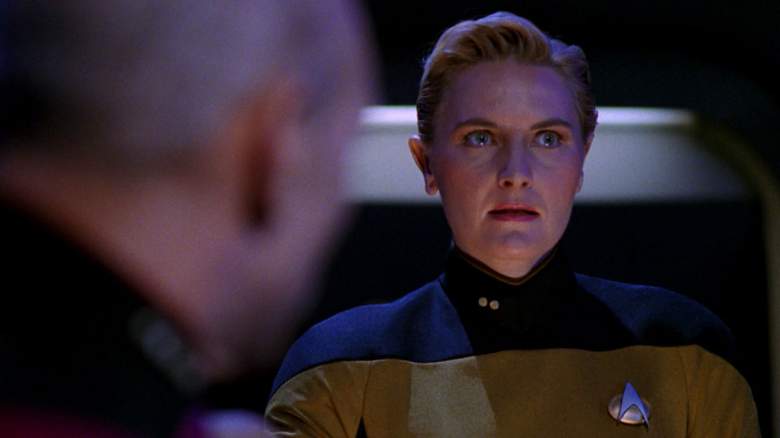
Paramount Denise Crosby as Tasha Yar
It was a pivotal moment in the first season of this new version of “Star Trek.” In a moment of crisis, a member of the Enterprise crew took the brunt of an attack by a hostile alien and died unexpectedly. This was a shock to fans of both “Star Trek,” and those who enjoyed science fiction shows on television. Why would the writers of “Star Trek” allow such a popular character to die like this? Fans were just getting to understand their motivations and personality.
This introduction might sound a lot like what viewers experienced with the death of Hemmer (Bruce Horak) in the first season of “Star Trek: Strange New Worlds.” If a fan read the above and assumed it was about Hemmer, they would not be wrong. This identical situation happened nearly 35 years before on “Star Trek: The Next Generation” to the Enterprise’s security chief — Tasha Yar.
Armus
Yar was portrayed by Denise Crosby, who was ‘Tinseltown’ royalty. Crosby is the granddaughter of Hollywood legend Bing Crosby. But her role on “Star Trek” did not turn out to be as fulfilling as she had hoped.
“It was so great to see a woman take the job traditionally held by a man,” Crosby told the LA Times back in 1994. “But I couldn’t see doing that for six years.”
In a 2015 interview for StarTrek.com with Ian Spelling, Crosby elaborated on why she left “The Next Generation” so early.
“I always talk about a scene I had to audition [to TNG] with that never made it on to film, and I never understood that,” Crosby told Spelling in the interview. “That scene, to me, was what was so exciting and interesting about the character. She was really, deeply insecure and had this wonderful paradox going on. She was so physically capable and had this very strong persona, but inside was just this little girl that felt very much out of her depth.”
Armus on ‘Lower Decks’
“That was the scene that I had to audition with, and it gave me a clue to the character,” Crosby said. “And then nothing was ever done with that. I was always trying to find moments where I could sort of play that, as an actor, and have that stuff going on inside.
Crosby requested to leave, and the writers obliged. Her character was killed by an inky alien named Armus, who knew only hate. The “Skin of Evil” episode has since been said to be “bad” and “disappointing.” An episode of “Lower Decks” even spoofed the entire situation.
Crosby found that after she left the show, especially after the start of Season 3 when Michael Piller took over as the showrunner, the tone of the writing changed. Many say that Piller was “the man who saved ‘Star Trek,’” who shifted the focus from a situation-based show to one where the characters took center stage. Under Piller’s watch, personal stories like “Data’s Day,” “Inner Light,” or “Darmock” were possible. Crosby saw that change and told Spelling:
“It was really a letdown in a way, once the show got up and running.”
Her way back to “Star Trek” was much more enjoyable. As chronicled by Eric Stillwell in his book, “The Making of Yesterday’s Enterprise,” Crosby may have been joking when she asked to return.
Tasha’s Return
Stillwell, along with “friend and writing partner” Trent Christopher Ganino, was responsible for writing one of the best episodes of TNG until that point — “Yesterday’s Enterprise.” Even though he was not yet a professional writer, Ganino submitted the script to Paramount. At this time, anyone had the opportunity to submit a story for TNG, and Paramount would actually give it a read.
“Yesterday’s Enterprise” was the tale of a shift in space-time caused by the return of the Enterprise-C from the future. Captain Picard (Patrick Stewart) and everyone aboard the Enterprise-D were unaware of the changes that happened with the C traveled back in time. The absence of the C, 18 years in the past, caused a terrible war between the Klingons and the Federation. Only Guinan (Whoopi Goldberg) sensed something awry with how things were.
The altered timeline had a living Tasha Yar still aboard the Enterprise-D. And since the Federation was at war with the Klingons, there was no Worf (Michael Dorn) on the bridge. In the end, Yar returned to the past with the rest of the Enterprise-C crew and fought bravely, saving the future from endless war.
Data and Sela
That story, which Stillwell helped keep in front of the right people at Paramount, eventually was made into the episode, and Trek fans still rave about it. But by the time Trek writer Ronald D. Moore got his hands on the story to make adjustments, the return of Yar was already there.
In his book, Stillwell said that he saw Crosby at a Trek convention in San Jose in 1989 and struck up a conversation with her. He reported that she said he ought to “write a script to bring me back.”
Stillwell and Ganino took her at her word and began to write Yar into an idea they’d been working on together. After many revisions and additions, that story would eventually become “Yesterday’s Enterprise.”
From there, Crosby returned for the two-parter, “Unification,” in which she played Yar’s daughter, Sela. Instead of becoming a “what if” footnote in Trek history, Crosby’s return solidified her as a favorite among fans. She’s been involved with the franchise ever since, including in “Star Trek: Online” and the “Trekkies” fan films.
READ NEXT: Patrick Stewart and the Battle for Emmy Award Recognition
Comments
How Denise Crosby Talked Her Way Back Onto “Star Trek: The Next Generation”